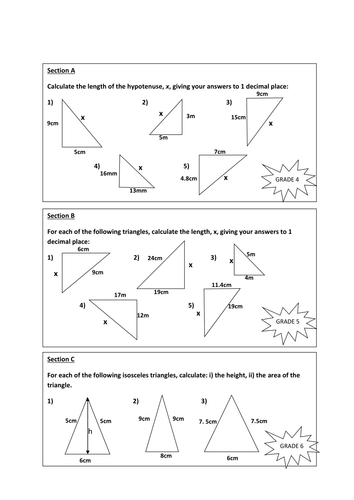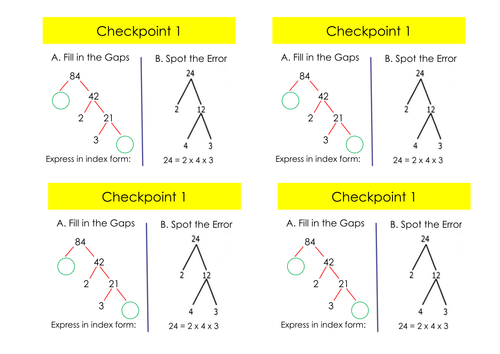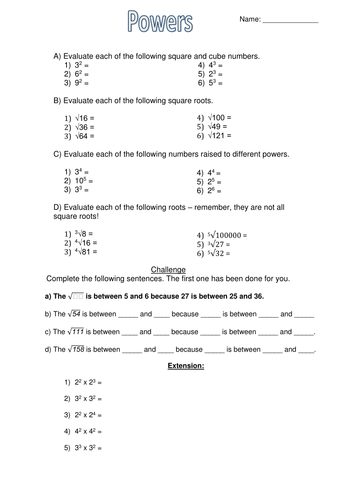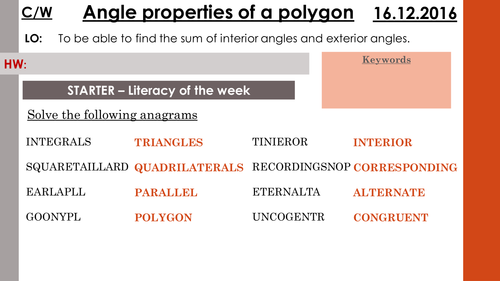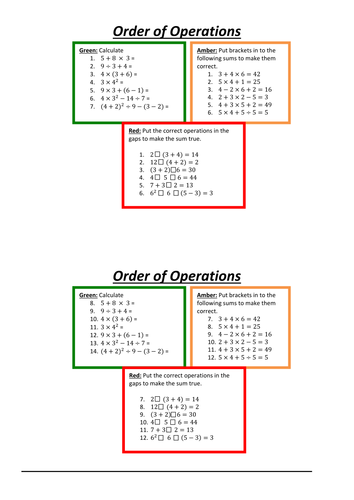
11Uploads
4k+Views
521Downloads
All resources

Constructing ASA and SAS triangles
This lesson is on constructing triangles accurately using a ruler and a protractor.
Starter: Pupils will draw some triangles to check and address misconceptions
Main: Teacher models two examples on how to construct a triangle when given the two sides and the included angle. Then students have a go!
Second Main: Teacher models two examples on how to construct a triangle when given two angles and a side. Then students have a go!
Star questions are provided whenever pupils have finished with the task.
Mini plenary: Testing their understanding by asking them to draw an equilateral triangle.
Plenary: They reflect on what they have learnt.
Hope you like it! Enjoy

Pythagoras Theorem
Starter tests their knowledge of square numbers and square roots.
Pre main - Pupils will try and get to the formula on their own by drawing the two blue triangles accurately or it can be provided by you.
Main - Teacher goes through two or three examples. This will help pupils to model their work appropriately.
Plenary - Good challenge question.

Corresponding and Alternate angles
This is following the new GCSE scheme of work. It breaks down corresponding and alternate angles to meet to the needs of Year 10s pupils who struggle to understand why the angles are equal.
The lesson is broken down into examples, questions and checkpoints. I reinforce the importance of checkpoints being their way of assessing their progress made in class. If they are able to do the checkpoints then they have made progress and met the learning objectives.
I have also attached the questions and super challenge questions to print out.
Let me know how it goes! Enjoy :)

Highest Common Factor and Lowest Common Multiple
Target at: Top and bottom sets (Hide the slides that you don't need)
Starter: Mark homework or numeracy worksheet.
Main: Explain how to find the highest common factor by both finding the factors and using factor trees. Then they will have a turn to find the highest factors only!
Second main: Explain how to find the lowest common multiple and then they will have some questions to do on their own.
Checkpoints: Testing their understanding of factors and spotting mistakes.
Plenary: Giving them a functional maths questions to check their understanding.
Let me know how it goes! Enjoy :)

Percentage Increase and Decrease
Starter: Silent starter worksheet where pupils convert between fractions, decimals and percentages. There is also 4 spider diagrams for them to find percentage of amounts.
Main: Teach pupils how to find percentage of amounts mentally. Then show them how to calculate percentage increase. They will have a set of questions to do with the answers on the following slide.
Second main: Slides to show how to calculate percentage decrease. This is followed by some questions for them to do and the answers are provided too.
Plenary: Mini checkpoint to check their understanding by asking them which one is greater.
Let me know how it goes!

Squares and Cubes
Targeted: Top set class
Starter: Square and square root number bingo!
Main: Go through some complex square number and square root questions with addition and subtraction involved. Then they will have a go! There is also some problem solving questions attached on the next slide.
Second Main: Go through the same process but with cube and cube roots.
Plenary: Activity on using everything they have covered and finding the quote. (Attached as the worksheet)
Let me know how it goes! Enjoy.

Polygons
Lovely literacy of the week to get them completely hooked. This lesson is on interior angles and gives pupils the chance to come up with the formula on their own.
Hope you like it!

HCF and LCM using Venn Diagrams
Targeted at: Mixed abilities
Starter: Writing numbers as a product of prime factors.
Main: Recap what the terms mean and then go through some familiar examples using the venn diagrams. Two examples is enough. Then they will have a go!
Second main: Go through one of the functional maths problems with them and then they can have a go!
Plenary: Reflection on the lesson.
Let me know how it goes! Enjoy :)

Order of Operations
Targeted at: Mixed abilities
Starter: Check their prior knowledge on BIDMAS.
Main: Go through some examples and then pupils will have a chance to show their understanding through the mini whiteboard activity. Then they will do some questions on their own.
Checkpoint: Check to see how much progress they have made in the lesson.
Plenary: Countdown!

Index Laws
Starter: Checking pupils prior knowledge and talking about indices
Main: Go through the rules whilst picking pupils to answer questions to check understanding and learning. Entice them with a codebreaker to get them to practice some questions using the rules.
Checkpoints: Checking to see how much they have taken from this lesson and address any misconceptions before ending the lesson with a plenary.
Plenary: Spot the mistakes activity

Percentage Increase and Decrease using the Multiplier
Starter: Silent starter - pupils work on some worded problems. Related to percentage of amounts.
Main: Introduce pupils to percentage increase using the multiplier and demonstrate how to find the multiplier. Pupils will be able to show their understanding through the mini whiteboard activity which allows them to find the multiplier for only percentage increase. Then set them some questions which are followed by the answers.
Second Main: Model a percentage decrease question using the multiplier and then they work on matching the multiplier to the correct percentage decrease. It is followed by some questions where the answers are also provided.
Plenary: Problem solving activity to be done as a group and can be set as group homework. Lovely way to involve some presentation work next lesson.
Let me know how it goes!


